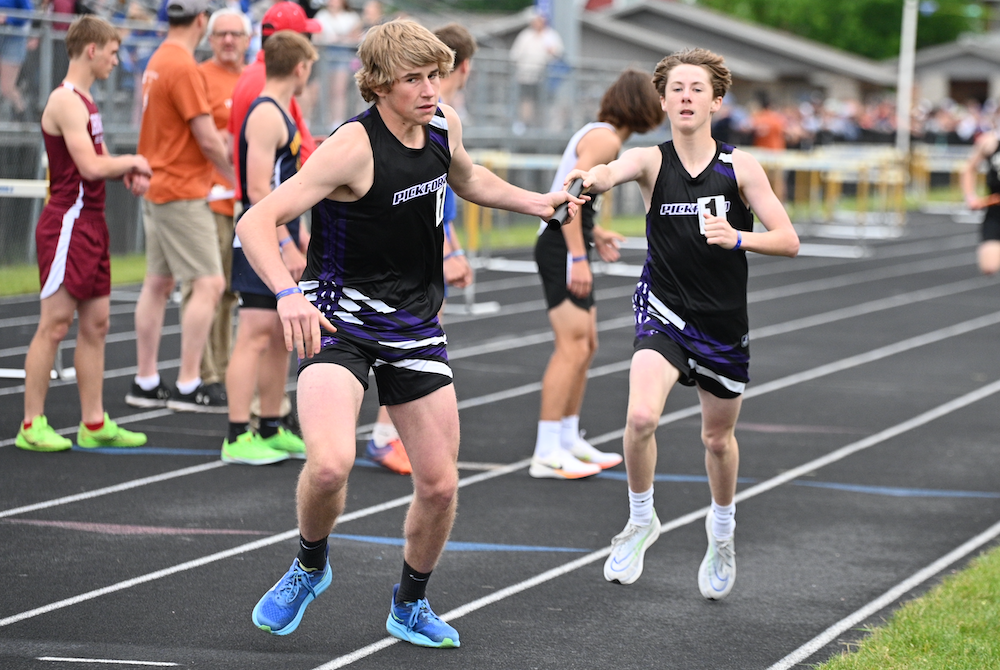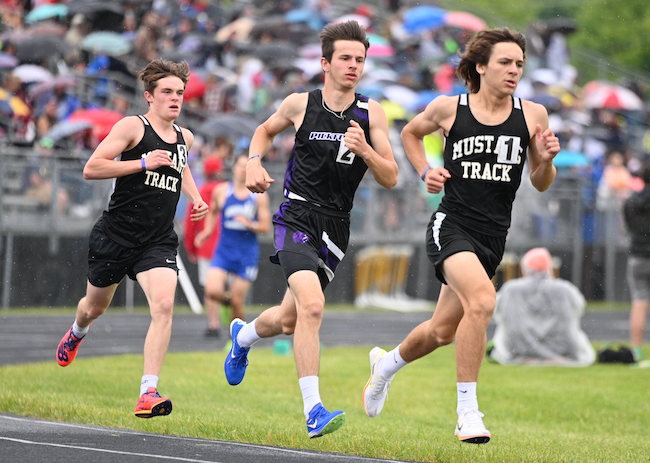
Classes Still Create Hoosier Hysteria
July 27, 2017
By Rob Kaminski
MHSAA benchmarks editor
This is the fourth part in a series on MHSAA tournament classification, past and present, that will be published over the next two weeks. This series originally ran in this spring's edition of MHSAA benchmarks.
Twenty years ago, Bloomington North High School won the Indiana High School Athletic Association boys basketball championship, defeating Delta 75-54 at the RCA Dome in Indianapolis.
The date, March 22, 1997, is at the same time revered and disdained by traditionalists in the state who saw it as the last schoolboy championship game the state would ever host.
That’s how devout the game of basketball, particularly interscholastic basketball, had become in the Hoosier state during the 87 years a state champion – one state champion, to be precise – was crowned.
Following that 1997 season, the IHSAA moved to a four-class system for its roundball tournaments, like so many of its state association counterparts had done years earlier.
It would be shocking to find more than a small percentage of current high school basketball players around the country unfamiliar with the iconic movie Hoosiers, even though the film is now more than 30 years old.
And, the storyline for that blockbuster unfolded more than 30 years prior to its release, when small-town, undermanned Milan High School defeated Muncie Central High School 32-30 in the 1954 IHSAA title game.
Perhaps it’s because of the David vs Goliath notion, or the fame of the movie that replaced Milan with the fictional Hickory and real-life star Bobby Plump with Hollywood hero Jimmy Chitwood, or the simple fact that Indiana had something other states didn’t.
Whatever the reason, plenty of opposition remains to this day to basketball classification in the state.
The fact is, the small rural schools were regularly being beaten handily by the much larger suburban and city schools as the tournament progressed each season.
Small schools also were closing at a rapid rate following the state’s School Reorganization Act in 1959, as students converged on larger, centralized county schools. From 1960 to 2000, the number of schools entering the tournament dropped from 694 to 381, and in 1997 a total of 382 schools and 4,584 athletes began competition at the Sectional level (the first level of the IHSAA Basketball Tournament).
It was at the entry level of the tournament where school administrators felt the pain of the new class system, but not necessarily for the same nostalgic reasons as the fans who either attended or boycotted the tournament.
At the Sectional round of the tournament, the IHSAA was culling just 2 percent of the revenue, with the participating schools splitting the balance. So, when Sectional attendance dropped by 14 percent in that first year of class basketball, many schools realized a financial loss. It was money they had grown to count on in prior years to help fund various aspects of the department.
Schools cumulatively received more than $900,000 from Sectional competition in 1998, but that total was down from more than $1 million in the last year of the single-class tournament.
Yet, the current format provides a great deal more opportunity and realistic chances at championship runs for schools of all enrollments.
To date, 60 additional teams have championship or runner-up trophies on display in school trophy cases around Indiana.
That was the mission in front of then-IHSAA commissioner Bob Gardner (now National Federation executive director) once the board made its decision: to give thousands more student-athletes the opportunity for once-in-a-lifetime experiences.
As any statistician knows, figures can be manipulated to tell any side of a story. Declining attendance in year one of class basketball is such a number.
The truth is tournament attendance had been on a steady downward spiral since its peak of just over 1.5 million in 1962. By the last single-class event in 1997, the total attendance was half that.
The challenge then and today, as it is for all state associations, is to find that delicate balance for those holding onto tradition, those holding onto trophies, and the number of trophies to hand out.
Editor’s Note: Stories from the Fort Wayne Journal Gazette in 1998 and from a 2007 issue of Indianapolis Monthly provided facts in this article.

Pickford Wins Matchup of Reigning Champions to Run Title Streak to 3
By
John Vrancic
Special for MHSAA.com
June 2, 2024
KINGSFORD — The Pickford boys extended their championship reign here Saturday, retaining top honors at the Upper Peninsula Division 2 Track & Field Finals with 137 points.
They were followed by Munising with 106 and Ishpeming with 79. The team championship was the Panthers’ third straight, as they also won Division 3 in 2022.
Sophomore Gunner Bennin was a double-winner for Pickford, taking the 200-meter dash in 23.85 seconds and 400 at 53.36.
“It feels great to come here and win a couple events as a sophomore,” he said. “We knew Iron Mountain had some good sprinters, and Munising is tough. We needed the points. I started faster than I usually do, especially in the 400.
Senior Hayden Hagen provided the Panthers with a first in the 800 (2:05.03), and sophomore John Anderson won high jump at 5 feet, 8 inches.
Panthers junior Tom Storey was runner-up in pole vault (10-6) and high jump (5-7). Hagen was runner-up to Munising junior Dan Goss in the 1,600 (4:39.84) and 3,200 (10:30.81).
Goss ran a personal-best 4:33.98 in the 1,600 and was clocked at 10:23.9 in the 3,200, and anchored the winning 3,200 relay (8:50.22).
 “I like the weather today,” he said. “It was a little humid during the 3,200. Otherwise, it was a good day for running. That was a 10-second PR (personal record) in the 1,600. I’m real happy with that. I’ve been training my tail off the last two weeks.
“I like the weather today,” he said. “It was a little humid during the 3,200. Otherwise, it was a good day for running. That was a 10-second PR (personal record) in the 1,600. I’m real happy with that. I’ve been training my tail off the last two weeks.
“The field events hurt us, but overall I’m happy with how our team did. I had a PR in every event including a split of 2 minutes flat in the 3,200 relay.”
Munising – the Division 3 champion in 2023 – also took the 800 relay (1:36.19), and Pickford was runner-up (1:38.18). The Panthers claimed the 1,600 relay (3:43.36) and placed second in the 3,200 (8:52.74).
Munising senior Joe Kelley added firsts in the 110 hurdles (16.46) and the 300s (42.12) and helped the Mustangs take second in the 400 relay (46.19) and 1,600 (3:48.86). Mustangs’ senior Trevor Nolan added a third in the 1,600 (4:43.41), followed by Bark River-Harris freshman Ben Knauf in a personal-best 4:48.04.
Ishpeming got a first on senior Brayden Martin’s throw of 123-9¼ in discus, and Hancock senior Myles Lewis took shot put (42-11½).
The Hematites got seconds from senior Tramon Gauthier in long jump (18-7¾), 110 hurdles (16.47) and 300s (43.62), and freshman Kemper Gearhart was third in the 3,200 (10:41.5).
Ironwood sophomore Talon Hughes placed second in the 100 (11.51) and 200 (23.98) and third in the 110 hurdles (16.55).
Iron Mountain senior Matt Colavecchi had a hand in three firsts, taking the 100 (11.44), long jump (19-8¼) and anchoring the winning 400 relay (45.92).
Rudyard got a first on junior Jaydon Niemi-Alcorn’s leap of 11-6 in pole vault. Taking runner-up for the Bulldogs were senior teammate Kaeden Sistrunk in shot put (40-8) and junior Ethan Hoolsema in discus (120-0).
PHOTOS (Top) Pickford's Jacob Mitchell hands off the baton to Eli MacDonald for the last leg of the 3,200 relay Saturday at Kingsford. (Middle) During a rainy 1,600, Munising's Dan Goss (1) leads the race with Pickford's Hayden Hagen (2) and Munising's Trevor Nolan (3) right behind him. (Click for more from Cara Kamps/RunMichigan.com.)

